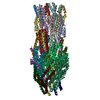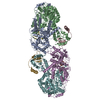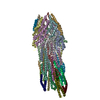[English] 日本語
 Yorodumi
Yorodumi- PDB-7agx: Apo-state type 3 secretion system export apparatus complex from S... -
+ Open data
Open data
- Basic information
Basic information
| Entry | Database: PDB / ID: 7agx | |||||||||
|---|---|---|---|---|---|---|---|---|---|---|
| Title | Apo-state type 3 secretion system export apparatus complex from Salmonella enterica typhimurium | |||||||||
 Components Components |
| |||||||||
 Keywords Keywords | PROTEIN TRANSPORT / T3SS / Export Apparatus / Injectisome / Needle Complex | |||||||||
| Function / homology |  Function and homology information Function and homology informationThe IPAF inflammasome / type III protein secretion system complex / protein secretion by the type III secretion system / protein secretion / protein targeting / protein transport / cell surface / extracellular region / identical protein binding / plasma membrane Similarity search - Function | |||||||||
| Biological species |  Salmonella typhimurium (bacteria) Salmonella typhimurium (bacteria) | |||||||||
| Method | ELECTRON MICROSCOPY / single particle reconstruction / cryo EM / Resolution: 3.6 Å | |||||||||
 Authors Authors | Goessweiner-Mohr, N. / Fahrenkamp, D. / Miletic, S. / Wald, J. / Marlovits, T. | |||||||||
| Funding support |  Austria, Austria,  Germany, 2items Germany, 2items
| |||||||||
 Citation Citation |  Journal: Nat Commun / Year: 2021 Journal: Nat Commun / Year: 2021Title: Substrate-engaged type III secretion system structures reveal gating mechanism for unfolded protein translocation. Authors: Sean Miletic / Dirk Fahrenkamp / Nikolaus Goessweiner-Mohr / Jiri Wald / Maurice Pantel / Oliver Vesper / Vadim Kotov / Thomas C Marlovits /   Abstract: Many bacterial pathogens rely on virulent type III secretion systems (T3SSs) or injectisomes to translocate effector proteins in order to establish infection. The central component of the injectisome ...Many bacterial pathogens rely on virulent type III secretion systems (T3SSs) or injectisomes to translocate effector proteins in order to establish infection. The central component of the injectisome is the needle complex which assembles a continuous conduit crossing the bacterial envelope and the host cell membrane to mediate effector protein translocation. However, the molecular principles underlying type III secretion remain elusive. Here, we report a structure of an active Salmonella enterica serovar Typhimurium needle complex engaged with the effector protein SptP in two functional states, revealing the complete 800Å-long secretion conduit and unraveling the critical role of the export apparatus (EA) subcomplex in type III secretion. Unfolded substrates enter the EA through a hydrophilic constriction formed by SpaQ proteins, which enables side chain-independent substrate transport. Above, a methionine gasket formed by SpaP proteins functions as a gate that dilates to accommodate substrates while preventing leaky pore formation. Following gate penetration, a moveable SpaR loop first folds up to then support substrate transport. Together, these findings establish the molecular basis for substrate translocation through T3SSs and improve our understanding of bacterial pathogenicity and motility. | |||||||||
| History |
|
- Structure visualization
Structure visualization
| Movie |
 Movie viewer Movie viewer |
|---|---|
| Structure viewer | Molecule:  Molmil Molmil Jmol/JSmol Jmol/JSmol |
- Downloads & links
Downloads & links
- Download
Download
| PDBx/mmCIF format |  7agx.cif.gz 7agx.cif.gz | 966.5 KB | Display |  PDBx/mmCIF format PDBx/mmCIF format |
|---|---|---|---|---|
| PDB format |  pdb7agx.ent.gz pdb7agx.ent.gz | Display |  PDB format PDB format | |
| PDBx/mmJSON format |  7agx.json.gz 7agx.json.gz | Tree view |  PDBx/mmJSON format PDBx/mmJSON format | |
| Others |  Other downloads Other downloads |
-Validation report
| Summary document |  7agx_validation.pdf.gz 7agx_validation.pdf.gz | 1.6 MB | Display |  wwPDB validaton report wwPDB validaton report |
|---|---|---|---|---|
| Full document |  7agx_full_validation.pdf.gz 7agx_full_validation.pdf.gz | 1.6 MB | Display | |
| Data in XML |  7agx_validation.xml.gz 7agx_validation.xml.gz | 84.7 KB | Display | |
| Data in CIF |  7agx_validation.cif.gz 7agx_validation.cif.gz | 134.1 KB | Display | |
| Arichive directory |  https://data.pdbj.org/pub/pdb/validation_reports/ag/7agx https://data.pdbj.org/pub/pdb/validation_reports/ag/7agx ftp://data.pdbj.org/pub/pdb/validation_reports/ag/7agx ftp://data.pdbj.org/pub/pdb/validation_reports/ag/7agx | HTTPS FTP |
-Related structure data
| Related structure data |  11780MC  7ah9C  7ahiC M: map data used to model this data C: citing same article ( |
|---|---|
| Similar structure data |
- Links
Links
- Assembly
Assembly
| Deposited unit | 
|
|---|---|
| 1 |
|
- Components
Components
| #1: Protein | Mass: 25249.596 Da / Num. of mol.: 5 / Source method: isolated from a natural source Source: (natural)  Salmonella typhimurium (strain LT2 / SGSC1412 / ATCC 700720) (bacteria) Salmonella typhimurium (strain LT2 / SGSC1412 / ATCC 700720) (bacteria)References: UniProt: P40700 #2: Protein | | Mass: 28499.533 Da / Num. of mol.: 1 / Source method: isolated from a natural source Source: (natural)  Salmonella typhimurium (strain LT2 / SGSC1412 / ATCC 700720) (bacteria) Salmonella typhimurium (strain LT2 / SGSC1412 / ATCC 700720) (bacteria)References: UniProt: P40701 #3: Protein | Mass: 9363.229 Da / Num. of mol.: 4 / Source method: isolated from a natural source Source: (natural)  Salmonella typhimurium (strain LT2 / SGSC1412 / ATCC 700720) (bacteria) Salmonella typhimurium (strain LT2 / SGSC1412 / ATCC 700720) (bacteria)References: UniProt: P0A1L7 #4: Protein | Mass: 10934.425 Da / Num. of mol.: 6 / Source method: isolated from a natural source Source: (natural)  Salmonella typhimurium (strain LT2 / SGSC1412 / ATCC 700720) (bacteria) Salmonella typhimurium (strain LT2 / SGSC1412 / ATCC 700720) (bacteria)References: UniProt: P41785 #5: Protein | Mass: 8864.868 Da / Num. of mol.: 17 / Source method: isolated from a natural source Source: (natural)  Salmonella typhimurium (strain LT2 / SGSC1412 / ATCC 700720) (bacteria) Salmonella typhimurium (strain LT2 / SGSC1412 / ATCC 700720) (bacteria)References: UniProt: P41784 |
|---|
-Experimental details
-Experiment
| Experiment | Method: ELECTRON MICROSCOPY |
|---|---|
| EM experiment | Aggregation state: PARTICLE / 3D reconstruction method: single particle reconstruction |
- Sample preparation
Sample preparation
| Component | Name: Export apparatus core complex with inner rod and needle filament proteins PrgJ and PrgI. Type: COMPLEX / Details: Apo-state / Entity ID: all / Source: NATURAL |
|---|---|
| Molecular weight | Value: 0.336 MDa / Experimental value: NO |
| Source (natural) | Organism:  Salmonella enterica subsp. enterica serovar Typhimurium str. LT2 (bacteria) Salmonella enterica subsp. enterica serovar Typhimurium str. LT2 (bacteria)Cellular location: Membrane |
| Buffer solution | pH: 8 |
| Specimen | Embedding applied: NO / Shadowing applied: NO / Staining applied: NO / Vitrification applied: YES |
| Vitrification | Cryogen name: ETHANE-PROPANE |
- Electron microscopy imaging
Electron microscopy imaging
| Experimental equipment |  Model: Titan Krios / Image courtesy: FEI Company |
|---|---|
| Microscopy | Model: TFS KRIOS |
| Electron gun | Electron source:  FIELD EMISSION GUN / Accelerating voltage: 300 kV / Illumination mode: SPOT SCAN FIELD EMISSION GUN / Accelerating voltage: 300 kV / Illumination mode: SPOT SCAN |
| Electron lens | Mode: BRIGHT FIELD |
| Image recording | Electron dose: 31.5 e/Å2 / |
 Movie
Movie Controller
Controller











 PDBj
PDBj

